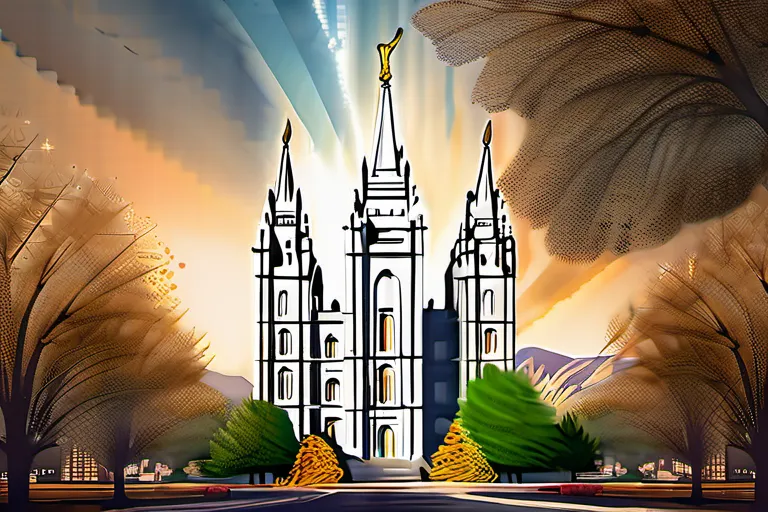Explore the history, beliefs, practices, and unique aspects of the LDS Church.
The Church of Jesus Christ of Latter-day Saints, often referred to as the LDS Church or Mormonism, is a significant religious organization with a rich history and unique beliefs. In this comprehensive guide, we delve into the origins, doctrines, practices, and distinctive features of the LDS Church.
The Origins of Mormonism
The story of Mormonism begins with a young man named Joseph Smith, who lived in upstate New York during the early 19th century. Born into a family that experienced both poverty and religious fervor, Joseph grew up hearing about various Christian denominations but felt a deep longing for spiritual truth. Could it be that he was destined to find what others had not? As a boy, Joseph would often retreat to the woods near his home, seeking answers through prayer.
One fateful day in 1820, while praying about which church he should join, Joseph claimed he saw a vision of God the Father and Jesus Christ. This pivotal moment, known as the First Vision, set the stage for what would become the LDS Church. Was this not a direct line to divine revelation? The experience left Joseph with a profound sense of direction but also confusion about how his revelations should be received by others.
In 1823, Joseph claimed another vision in which he was visited by an angel named Moroni, who directed him to a hidden scripture. For years, Joseph searched for these writings, guided by Moroni’s instructions. Finally, in 1827, with the help of his wife Emma and scribe Oliver Cowdery, he translated what would become known as the Book of Mormon. The book told of a lineage of prophets who lived in ancient America and offered a second witness of Jesus Christ.
The publication of the Book of Mormon marked the official founding of the Church of Jesus Christ of Latter-day Saints. Yet, Joseph faced immense opposition from those who doubted his claims. Was he truly a prophet or was this all a fabrication? The trials and persecutions that followed only strengthened his resolve to build a church based on divine revelation.
The establishment of the LDS Church in 1830 was just the beginning. Joseph Smith continued to receive visions, revelations, and commandments, which he documented in what is now known as the Doctrine and Covenants. These teachings formed the unique doctrines and practices that distinguish Mormonism from other Christian denominations.
Through the lens of history, we see a man who felt called to restore the true church of Jesus Christ. Joseph Smith’s story is one of faith, struggle, and ultimate triumph in spreading what he believed were divine truths. The LDS Church today stands as a testament to his vision and the ongoing revelations that continue to shape its beliefs and practices.
Could it be that every new member entering into the fold also experiences a similar journey, seeking answers and finding them through the teachings of the church? Joseph Smith’s story is not just about the founding of a religion; it is a tale of human faith and perseverance in the face of doubt.
How do you find your own path to truth?
The mormon journey is a complex one, filled with history, faith, and the ongoing search for divine guidance. As we delve deeper into the key beliefs and doctrines that define the LDS faith, we will explore these questions in more detail, understanding both the unique aspects of Mormonism and its broader impact on religious thought.
How does your own journey compare to Joseph Smith’s?
Key Beliefs and Doctrines
The Book of Mormon, often seen as a cornerstone of LDS belief, tells a fascinating story that intertwines ancient civilizations and prophetic revelations. Imagine a historical narrative woven through time, connecting modern-day followers to their spiritual ancestors. This sacred text is not merely a book but a bridge between the Old World and the New, leading believers to ponder the mysteries of past cultures and their relevance today.
Central to LDS doctrine are the Doctrines and Covenants, which provide guidance through practical teachings and commandments. These writings are akin to a roadmap for living a virtuous life, offering clarity on how to navigate the complexities of modern society while remaining faithful. Think about it—just as a map helps you find your way in unfamiliar territory, these scriptures help members of the LDS Church make informed decisions.
The concept of eternal marriage, or celestial sealing, is another unique aspect of LDS belief. It’s like marrying not just for this life but for all eternity, binding families together across generations. This belief challenges conventional views on matrimony and family, prompting members to reconsider the depth and breadth of their commitments.
Finally, the LDS Articles of Faith serve as a concise summary of core beliefs, much like a set of guiding principles for living. These articles offer a straightforward yet profound statement of faith, reinforcing key concepts such as the divinity of Jesus Christ, the restoration of the gospel, and the importance of personal revelation.
By exploring these doctrines and scriptures, one can truly appreciate the rich tapestry that makes up the LDS faith. Each belief and practice not only shapes individual lives but also contributes to a community bound by shared values and spiritual goals. It’s almost like looking into a mirror reflecting your own spiritual journey—challenging, complex, yet deeply rewarding.
The Role of Jesus Christ in Mormonism
The role of Jesus Christ in the Church of Jesus Christ of Latter-day Saints, often referred to as the LDS Church, cannot be overstated. He is not just a central figure but the core around which the entire faith revolves. Think of Him as the sun at the center of our solar system, with each planet representing a different aspect of His teachings and the Church’s beliefs.
According to LDS doctrine, Jesus Christ’s Atonement—His suffering and sacrifice on the cross—has provided a means for us to be saved. But what exactly does this mean? Is it just about forgiveness or is there more to it? The concept of atonement in Mormonism goes beyond mere redemption; it encompasses the idea that through Christ, we can experience full salvation and eternal life.
Eternal life is a cornerstone belief for Mormons. It’s not just about going to heaven after death but living forever with God and our loved ones. But how do we achieve this? The LDS Church teaches that through faith, repentance, baptism by immersion, receiving the gift of the Holy Ghost, and enduring until the end, one can inherit eternal life.
Jesus Christ is not seen as a historical figure but as a divine being who has come to earth multiple times. He is the same yesterday, today, and forever, and His role extends beyond that of a single life. This view of Jesus as both human and divine, as well as His ongoing presence in our lives, makes Him more than just a savior; He is a guide, a mentor, and an ever-present source of comfort and direction.
So, when we talk about the central role of Jesus Christ in LDS faith, it’s like discussing the heart of a tree. Just as the heartwood supports the entire structure, Jesus Christ’s teachings and example form the backbone of Mormonism. He is not just a historical figure or a distant deity but a living presence who guides us through every challenge and triumph in our lives.
How do you view the role of Jesus Christ in your own faith? Is His atonement something you believe can change your life, or is it more about following rules and practices?
LDS Practices and Rituals
In the LDS Church, rituals and practices are like a map leading believers to spiritual depth and understanding. Imagine baptism as the key that unlocks a new door in your heart; it’s more than just water splashing over your head—it’s an act of symbolizing death to sin and resurrection to a new life. How many times have you pondered, ‘What does true repentance look like?’ For Latter-day Saints, it isn’t just saying sorry but truly turning away from wrongdoing and embracing the light of Christ in their lives.
The sacrament, with its simple elements of bread and water, is a powerful reminder of Jesus Christ’s sacrifice. It’s more than an afterthought or mere ritual; it’s a vital part of the daily life of members. Do you ever wonder why the scriptures say to partake of it “as often as [you] can”? It’s because this act, performed frequently, helps keep the covenant of baptism fresh in our minds and hearts. How many times have you seen children approaching the alter for their first sacrament? Their faces hold a mix of excitement and solemnity, mirroring the profound significance of the moment.
Temple worship is like stepping into a sacred realm where time seems to bend. It’s not just about following instructions but engaging in deep spiritual experiences. Think of it as a garden—beautiful, serene, and full of purpose. Here, ordinances such as endowments and sealings are performed, binding families together for eternity. Have you ever considered the profound impact these practices have on the family unit? They create bonds that transcend death and time, ensuring that loved ones remain connected no matter what.
Through these rituals and practices, members of the LDS Church find a rich tapestry of faith and tradition. Each step is deliberate and meaningful, weaving together layers of spiritual growth and understanding. How can you incorporate these practices into your life to deepen your own spirituality?
The LDS Church Today
The LDS Church today stands as a vibrant tapestry, woven across continents and cultures. How has it managed to grow from a small group in the mid-19th century to a global institution with millions of members? The answer lies in its adaptability and commitment to spreading its message.
The growth of the LDS Church can be likened to the expansion of a vine, spreading rapidly yet gracefully. From its roots in rural Utah, it has now thrived across North America, Europe, Asia, Africa, and South America. This global presence is not just numerical; it’s about building communities that reflect the core values of the church—service, charity, and faith.
The challenges faced by the LDS Church today are as varied as its membership. One of the most pressing issues is navigating the complexities of modern society while maintaining traditional beliefs. How does a religion that emphasizes doctrinal purity adapt to a world increasingly focused on inclusivity and diversity?
Another challenge lies in combating misinformation and negative stereotypes. The LDS Church has been a target for criticism, often unfairly portrayed in media and online discourse. ‘Is the church truly misunderstood or are there aspects of its teachings that might be misinterpreted?’ These questions underscore the importance of clear communication and education.
The church’s response to these challenges is multifaceted. It has invested heavily in outreach programs, community services, and educational initiatives to foster a better understanding of its beliefs and practices. Additionally, it continues to modernize its methods of worship and communication, integrating technology into its services while preserving traditional values.
Mormonism and Society
How does one society impact another? In the case of the Church of Jesus Christ of Latter-day Saints, also known as the LDS Church or Mormonism, its influence on various aspects of modern society is profound and multifaceted. From the political arena to educational institutions, and even in the cultural fabric that binds communities together, the Mormons have left an indelible mark.
Let’s dive into the intricate web of how Mormonism intersects with public life. Can we truly understand American politics without considering the voice of a significant religious group like the LDS Church? The influence of Mormon leaders and supporters in political discourse is undeniable, often shaping policy debates on issues such as family values, social justice, and economic policies.
Moreover, Mormonism has a rich tradition of educational institutions that play a pivotal role in American higher education. Brigham Young University (BYU) alone educates tens of thousands of students each year, contributing to the intellectual landscape of the nation. But why stop there? How do these universities foster an environment that not only excels academically but also promotes values such as integrity and service?
Culturally, the LDS Church’s influence is evident in the way it integrates into daily life. Festivals, social gatherings, and community service projects are just some of the ways Mormons contribute to their communities. But isn’t this community engagement a reflection of Mormonism’s emphasis on building up society rather than tearing it down?
In essence, exploring the impact of LDS Mormon on society is like peeling back layers of an onion; each layer reveals more complexity and nuance. From political influence to educational advancements and cultural contributions, the LDS Church’s presence in American life is multifaceted and far-reaching. It serves as a reminder that religion plays a critical role in shaping not just individual lives but also the fabric of society as a whole.
Conclusion
 By understanding the history, beliefs, and practices of the LDS Church, you’ll gain valuable insights into one of the world’s fastest-growing religions. Embrace this knowledge to foster greater tolerance and appreciation for religious diversity.
By understanding the history, beliefs, and practices of the LDS Church, you’ll gain valuable insights into one of the world’s fastest-growing religions. Embrace this knowledge to foster greater tolerance and appreciation for religious diversity.











